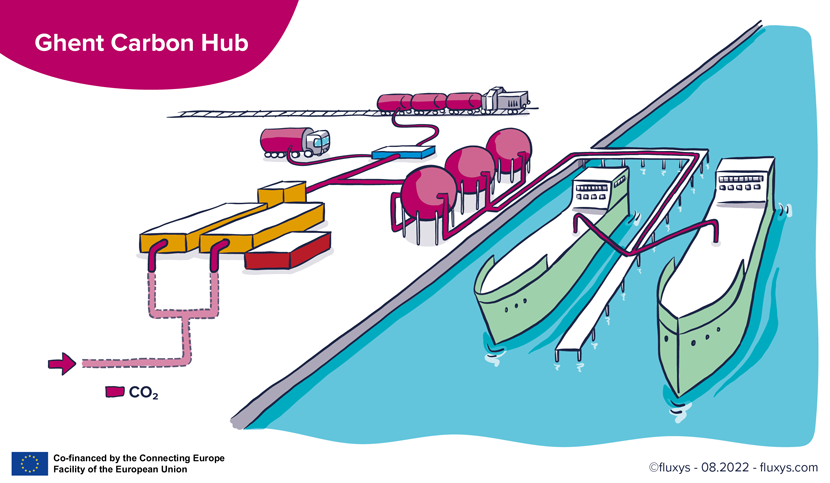Ghent Carbon Hub
Fluxys Belgium, North Sea Port and ArcelorMittal Belgium receive EU funding for Ghent Carbon Hub project, a key step towards decarbonising Belgium

On 8 December 2022 the EU Commission has announced it will grant Fluxys Belgium, North Sea Port and ArcelorMittal Belgium €9,6 million under the Connecting Europe Facility for Energy (CEF-E) funding program. The funding is earmarked for the study of the Ghent Carbon Hub project, an open-access multi modal CO2 storage and liquefaction terminal in North Sea Port combined with a CO2 pipeline network connecting the Walloon region to the hub in Ghent.
Ghent Carbon Hub is set up as an open-access infrastructure including a CO2 storage and liquefaction terminal and a pipeline network collecting CO2 from emitters. The liquefied CO2 will be loaded onto ships for onward permanent offshore storage. Ghent Carbon Hub will have a capacity to process up to 4 million tonnes of CO2 per year, equivalent to around 10% of Belgian industrial CO2 emissions. As part of the development of the CO2 Belgian infrastructure, and also supported by the grant of the European Commission, Fluxys is developing a connection between Mons and Ghent to offer export options for the CO2 emitters located in Wallonia. The grant award for the - ongoing - study is a major step towards the final investment decision expected in 2025, and targeted to be in operation by 2027.
The three partners are pressing ahead to develop this key infrastructure accommodating the carbon capture, transport and storage chain, which is paramount for CO2 intensive industries to achieve net zero emissions, especially in hard-to-abate sectors with processes inherently generating CO2 emissions.
North Sea Port is home to an energy intensive cluster with a significant CO2 footprint. The port, together with the companies located in this area, work towards a reduction of CO2 emissions. As a first step, the capture and storage of CO2 (Carbon Capture and Storage - CCS) will be increased. Required infrastructure has to be developed in order to enable further development and scaling the Carbon Capture Utilisation and Storage (CCUS) activities within North Sea Port, establishing the port’s position as CCUS Hub. In that perspective, the open-access CO2 terminal provided by the Ghent Carbon Hub project is a crucial building block in the transition to a future-proof industry and a carbon-neutral port by 2050.
In particular, ArcelorMittal Belgium is keen to develop different decarbonisation initiatives. Alongside their continued energy efficiency improvements, two routes to decarbonise steelmaking are being developed: Smart Carbon and Innovative-DRI. Both routes will contribute to the journey to deliver carbon-neutral steelmaking. The Smart Carbon route allows to integrate carbon capture and re-use (CCU) or storage (CCS) technologies.
The project will benefit from Fluxys’ wide experience in both pipeline transport and terminalling activities. With its CO2 pipeline infrastructure Fluxys is keen to collect CO2 at the emitters’ premises and to convey it safely to either an export facility where it can be liquefied and shipped to a storage facility, or a location where it can be re-used. Ghent Carbon Hub is among several projects Fluxys is involved in to offer exit points from its CO2-backbone towards CO2 sequestration: Antwerp@C (10 million tonnes per year) – offshore trunkline in Zeebrugge (20-40 million tonnes per year). Multiple projects are indeed needed to reach the European goals towards net zero: such projects combined with a robust CO2-backbone enable sufficient CO2 export capacity for emitters not only in Belgium but also in surrounding countries.
Pascal De Buck, CEO Fluxys Belgium: “We are very delighted with the EU support to this CO2 infrastructure project with ArcelorMittal Belgium and North Sea Port. This project is perfectly in line with Fluxys’ new strategy regarding the development of infrastructure for CO2 transport, with our ambition to offer to the market transmission capacities of up to 30 million tonnes of CO2 per year by 2030.Together with our partners, we are looking forward to developing a multimodal export platform for CO2 which will contribute to an efficient decarbonisation of the Belgian industry.”
Manfred Van Vlierberghe, CEO ArcelorMittal Belgium: “ArcelorMittal Belgium aims to reduce the CO2 emissions by 35% by 2030 compared to 2018, and has the ambition to become climate neutral by 2050. The combination of a new Direct Reduced Iron (DRI) plant alongside a sustainable, state-of-the-art blast furnace enables the creation of unique synergies in ArcelorMittal Belgium’s roadmap to climate-neutral steelmaking. Additionally ArcelorMittal Belgium focusses on CCS, where Ghent Carbon Hub is an essential building block in the full CO2 value chain from capturing till sequestration. Together with Fluxys and North Sea Port we are developing this solution to realize our ambitious climate objectives.”
Daan Schalck, CEO North Sea Port: “The industrial cluster in North Sea Port accounts for a large CO2 footprint and time is now to move towards a carbon-neutral economy. Ghent Carbon Hub holds the key to leverage this shift towards carbon neutrality and create a fully-fledged Carbon Capture Utilization and Storage (CCUS) ecosystem in North Sea Port. Therefore we are extremely pleased that the European Commission supports the engineering studies of the multi-modal CO2 infrastructure project which we are jointly developing with Fluxys and ArcelorMittal Belgium.”

The contents of this publication are the sole responsibility of ArcelorMittal Belgium, Fluxys Belgium and North Sea Port, and do not necessarily reflect the opinion of the European Union.